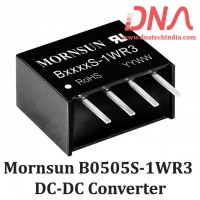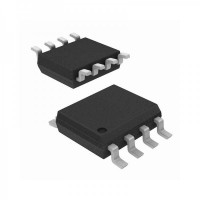Connecting Resistors Together |
||
|
Individual resistors can be connected together in either a series connection, a parallel connection or combinations of both series and parallel together, to produce more complex networks whose equivalent resistance is a combination of the individual resistors. Then complicated networks of resistors or impedances can be replaced by a single equivalent resistor or impedance. Whatever the combination or complexity of the circuit, all resistors obey Ohm's Law and Kirchoff's Circuit Laws. |
||
|
|
||
Resistors in Series |
||
|
Resistors are said to be connected in "Series", when they are daisy chained together in a single line. Since all the current flowing through the first resistor has no other way to go it must also pass through the second resistor and the third and so on. Then, resistors in series have a Common Current flowing through them as the current that flows through one resistor must also flow through the others as it can only take one path. Then the amount of current that flows through a set of resistors in series is the same at all points in a series circuit. For example: |
||
| IR1 = IR2 = IR3 = IAB = 1mA | ||
|
In the following example the resistors R1, R2 and R3 are all connected together in series between points A and B. |
||
|
|
||
Series Resistor Circuit |
||
|
|
||
|
As the resistors are connected together in series the same current passes through each resistor in the chain and the total resistance, RT of the circuit must be equal to the sum of all the individual resistors added together. That is |
||
|
RT = R1 + R2 + R3 |
||
|
and by taking the individual values of the resistors in our simple example above, the total equivalent resistance, REQ is therefore given as: |
||
|
REQ = R1 + R2 + R3 = 1kΩ + 2kΩ + 6kΩ = 9kΩ |
||
|
|
||
So we can replace all three individual resistors above with just one single equivalent resistor which will have a value of 9kΩ. Where four, five or even more resistors are all connected together in a series circuit, the total or equivalent resistance of the circuit, RT would still be the sum of all the individual resistors connected together and the more resistors added to the series, the greater the equivalent resistance (no matter what their value). This total resistance is generally known as the Equivalent Resistance and can be defined as; "a single value of resistance that can replace any number of resistors in series without altering the values of the current or the voltage in the circuit". |
||
|
Then the equation given for calculating total resistance of the circuit when connecting together resistors in series is given as: |
||
Series Resistor Equation |
||
| RTotal = R1 + R2 + R3 +......Rn etc. | ||
|
Note then that the total or equivalent resistance, RT has the same effect on the circuit as the original combination of resistors as it is the algebraic sum of the individual resistances. One important point to remember about resistors in series circuits, the total resistance (RT) of any two or more resistors connected together in series will always be GREATER than the value of the largest resistor in the chain and in our example above RT = 9kΩ were as the largest value resistor is only 6kΩ. |
||
|
|
||
Series Resistor Voltage |
||
|
The voltage across each resistor connected in series follows different rules to that of the series current. We know from the above circuit that the total supply voltage across the resistors is equal to the sum of the potential differences across R1 , R2 and R3 , VAB = VR1 + VR2 + VR3 = 9V. |
||
|
Using Ohm's Law, the voltage across the individual resistors can be calculated as: |
||
|
Voltage across R1 = IR1 = 1mA x 1kΩ = 1V |
||
|
Voltage across R2 = IR2 = 1mA x 2kΩ = 2V |
||
|
Voltage across R3 = IR3 = 1mA x 6kΩ = 6V |
||
|
giving a total voltage VAB of ( 1V + 2V + 6V ) = 9V which is equal to the value of the supply voltage. Then the sum of the potential differences across the resistors is equal to the total potential difference across the combination and in our example this is 9V. |
||
|
The equation given for calculating the total voltage in a series circuit which is the sum of all the individual voltages added together is given as: |
||
| RTotal = VR1 + VR2 + VR3 +......+ VN | ||
|
Then series resistor networks can also be thought of as "voltage dividers" and a series resistor circuit having N resistive components will have N-different voltages across it while maintaining a common current. |
||
|
By using Ohm's Law, either the voltage, current or resistance of any series connected circuit can easily be found and resistor of a series circuit can be interchanged without affecting the total resistance, current, or power to each resistor. |
||
|
|
||
Example No1 |
||
|
Calculate the equivalent resistance, series current, voltage drop and power for each resistor of the following resistors in series circuit. |
||
|
|
||
|
All the data can be found by using Ohm's Law, and to make life a little easier we can present this data in tabular form.
|
||
|
||
The Potential Divider Circuit |
||
|
Connecting resistors in series like this across a single DC supply voltage has one major advantage, different voltages appear across each resistor with the amount of voltage being determined by the resistors value only because as we now know, the current through a series circuit is common. This ability to generate different voltages produces a circuit called a Potential or Voltage Divider Network. |
||
|
The series circuit shown above is a simple potential divider where three voltages 1V, 2V and 6V are produced from a single 9V supply.Kirchoff's voltage laws states that "the supply voltage in a closed circuit is equal to the sum of all the voltage drops (IR) around the circuit" and this can be used to good effect as this allows us to determine the voltage levels of a circuit without first finding the current. |
||
|
The basic circuit for a potential divider network (also known as a voltage divider) for resistors in series is shown below. |
||
|
|
||
Potential Divider Network |
||
|
|
||
|
|
||
|
|
||
|
In this circuit the two resistors are connected in series across Vin, which is the power supply voltage connected to the resistor, R1, where the output voltage Vout is the voltage across the resistor R2 which is given by the formula. If more resistors are connected in series to the circuit then different voltages will appear across each resistor with regards to their individual resistance R (Ohms law IxR) providing different voltage points from a single supply. However, care must be taken when using this type of network as the impedance of any load connected to it can affect the output voltage. For example, |
||
|
Suppose you only have a 12V DC supply and your circuit which has an impedance of 50Ω requires a 6V supply. Connecting two equal value resistors, of say 50Ω each, together as a potential divider network across the 12V will do this very nicely until you connect your load circuit to the network. This is demonstrated below. |
||
|
|
||
Example No2 |
||
|
Calculate the voltage across X and Y. |
||
|
a) Without RL connected |
||
|
b) With RL connected |
||
|
|
||
|
As you can see from above, the output voltage Vout without the load resistor connected gives us the required output voltage of 6V but the same output voltage at Vout when the load is connected drops to only 4V, (Resistors in Parallel). Then the output voltage Vout is determined by the ratio of V1 to V2 with the effect of reducing the signal or voltage level being known as Attenuation so care must be taken when using a potential divider networks. The higher the load impedance the less is the loading effect on the output. |
||
|
A variable resistor, potentiometer or pot as it is more commonly called, is a good example of a multi-resistor potential divider within a single package as it can be thought of as thousands of mini-resistors in series. Here a fixed voltage is applied across the two outer fixed connections and the variable output voltage is taken from the wiper terminal. Multi-turn pots allow for a more accurate output voltage control. |
||
|
|
||
Resistors in Series Applications |
||
|
We have seen that resistors in series can be used to produce different voltages across themselves and this type of resistor network is very useful for producing a voltage divider network. If we replace one of the resistors in the voltage divider circuit above with a Sensor such as a thermistor, light dependant resistor (LDR) or even a switch, we can convert an analogue quantity being sensed into a suitable electrical signal which is capable of being measured. |
||
|
For example, the following thermistor circuit has a resistance of 10KΩ at 25°C and a resistance of 100Ω at 100°C. Calculate the output voltage (Vout) for both temperatures. |
||
Thermistor Circuit |
||
|
|
||
 |
||
|
At 25°C |
||
 |
||
|
At 100°C |
||
 |
||
|
By changing the fixed 1KΩ resistor, R2 in our simple circuit above to a variable resistor or potentiometer, a particular output voltage set point can be obtained over a wider temperature range. |
||
|
|
||
Resistors in Series Summary |
||
|
Then to summarise. When two or more resistors are connected together end-to-end in a single branch they are said to be connected together in series. Resistors in Series carry the same current, but the potential differences across them are not the same. In a series circuit the individual resistors add together to give the equivalent resistance, ( RT ) of the series combination. The resistors in a series circuit can be interchanged without affecting the total resistance, current, or power to each resistor or the circuit. |
||
|
In the next tutorial about Resistors, we will look at connecting resistors together in parallel and show that the total resistance is the reciprocal sum of all the resistors added together and that the voltage is common to a parallel circuit. |
||
|
|
||
|
Reproduced with permission from Wayne Storr |
||









